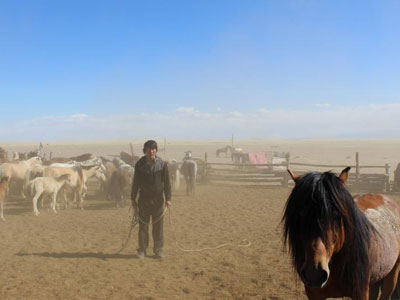PNAS:马的驯化的遗传学

一项研究发现,对古代马标本的基因组测序揭示出了现代驯化的马物种在驯化中经历了运动、生理与认知的变化,还揭示出了它的驯化导致了大量有害基因突变的积累。研究马的驯化的遗传基础一直受到了缺乏用于比较的亲缘关系密切的野马物种的限制。
Ludovic Orlando及其同事对来自俄罗斯的古代马标本的基因组进行了测序,这些样本的年代是距今大约1.6万年到4.3万年,这远远早于马在大约5500年前被驯化的时间。这组作者比较了5种现代驯化品种与亲缘关系遥远的Przewalski马的基因组,后者是唯一现存的野马物种。这些比较揭示出了这些古代标本与现代驯化品种的遗传相似性比Przewalski马更多,这提示驯化品种至少部分起源于这些古代种群。
这组作者还鉴别出了在驯化过程中受到偏爱的基因群,包括涉及肌肉、四肢、关节和心脏系统发育的基因,这说明了可能源于人类使用的身体适应。此外,与社会行为、学习能力、恐惧响应以及宜人性有关的基因的变化可能说明了这个驯化过程。现代马品种的基因组还含有大量的有害基因突变,这可能是由于近亲繁殖,这代表了驯化的代价。这组作者说,这些结果为马的驯化的遗传基础提供了部分解读。
原文标题:Prehistoric genomes reveal the genetic foundation and cost of horse domestication
原文摘要:The domestication of the horse ∼5.5 kya and the emergence of mounted riding, chariotry, and cavalry dramatically transformed human civilization. However, the genetics underlying horse domestication are difficult to reconstruct, given the near extinction of wild horses. We therefore sequenced two ancient horse genomes from Taymyr, Russia (at 7.4- and 24.3-fold coverage), both predating the earliest archeological evidence of domestication. We compared these genomes with genomes of domesticated horses and the wild Przewalski’s horse and found genetic structure within Eurasia in the Late Pleistocene, with the ancient population contributing significantly to the genetic variation of domesticated breeds. We furthermore identified a conservative set of 125 potential domestication targets using four complementary scans for genes that have undergone positive selection. One group of genes is involved in muscular and limb development, articular junctions, and the cardiac system, and may represent physiological adaptations to human utilization. A second group consists of genes with cognitive functions, including social behavior, learning capabilities, fear response, and agreeableness, which may have been key for taming horses. We also found that domestication is associated with inbreeding and an excess of deleterious mutations. This genetic load is in line with the “cost of domestication” hypothesis also reported for rice, tomatoes, and dogs, and it is generally attributed to the relaxation of purifying selection resulting from the strong demographic bottlenecks accompanying domestication. Our work demonstrates the power of ancient genomes to reconstruct the complex genetic changes that transformed wild animals into their domesticated forms, and the population context in which this process took place.
作者:Mikkel Schubert

